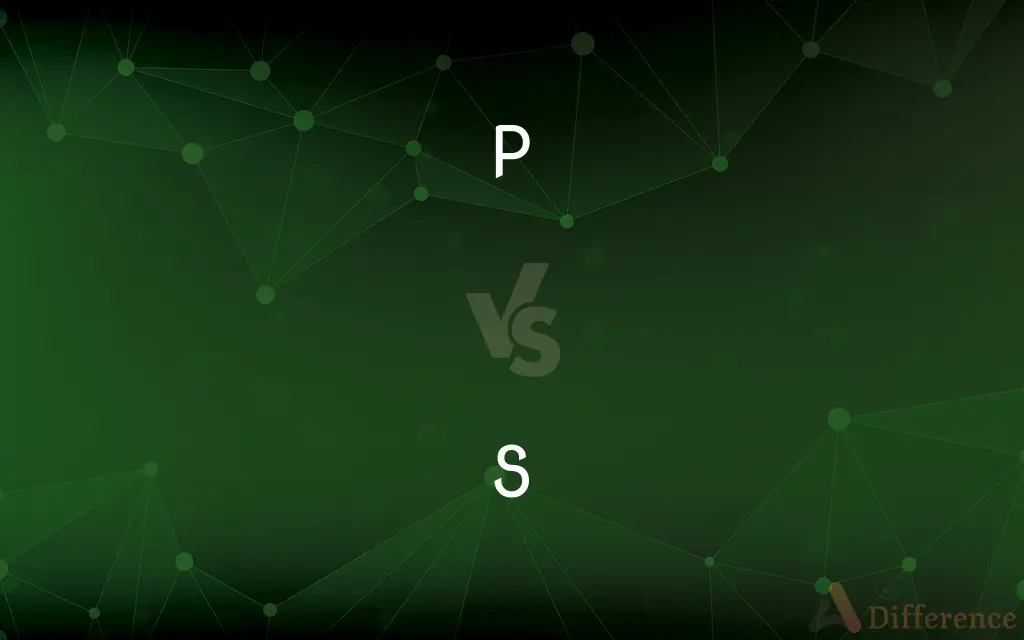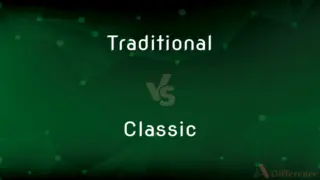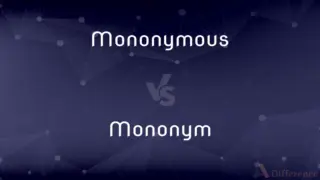P vs. S — What's the Difference?
By Tayyaba Rehman & Fiza Rafique — Updated on May 2, 2024
"P" represents the 16th letter of the alphabet used in various languages, while "S" is the 19th letter, often associated with a hissing sound.

Difference Between P and S
Table of Contents
ADVERTISEMENT
Key Differences
"P" is a voiceless bilabial plosive, produced by blocking airflow using the lips then releasing it explosively. In contrast, "S" is a voiceless alveolar sibilant, made by directing air flow between the tongue and the roof of the mouth. This difference in articulation leads to the distinct sounds each letter contributes to the phonetic landscape of a language.
In English, "P" can signal the start of words like 'play' or 'power', introducing a sharp, popping sound. Meanwhile, "S" starts words like 'snake' or 'sing', where it creates a prolonged hissing noise. This auditory distinction plays a crucial role in phonetics and linguistics, as "P" and "S" also differ in their role in syllable formation and word construction.
For instance, "P" often appears both at the beginning and ends of words, such as 'pop' or 'tap', whereas "S" can frequently be found at the start or as a marker of plurals and verb tenses, as seen in 'cats' or 'writes'.
Comparison Chart
Phonetics
Voiceless bilabial plosive
Voiceless alveolar sibilant
Sound Production
Lips blocking and releasing air
Tongue near roof of mouth directing air
ADVERTISEMENT
Common Usage in Words
Start of words (play), Ends of words (tap)
Starts words (snake), Plurals/tenses (cats)
Symbolic Representation
Stands for probability in mathematics
Symbolizes entropy in physics
Example Words
Pop, Tap, Slip (middle)
Snake, Silly, Passes (middle)
Compare with Definitions
P
Often used in logos for its strong, balanced lines.
The P in the Pinterest logo is stylized and recognizable.
S
Used in logos for its curvy shape that flows.
The S in the Skype logo is elegant and flowing.
P
Can indicate politeness or permission in abbreviations.
P stands for please in text messages.
S
Symbol for entropy.
In formulas, S represents the degree of disorder or randomness.
P
The 16th letter of the English alphabet.
P is essential in spelling words like 'party' and 'purple'.
S
Represents a voiceless alveolar sibilant.
The letter S in snake hisses smoothly.
P
Symbol for probability.
P used in the equation P(A) represents the likelihood of event A.
S
The 19th letter of the English alphabet.
S starts many common words like 'sun' and 'sand'.
P
Represents a voiceless bilabial plosive.
The letter P in pop explodes from the lips.
S
Marks plurals and present tense verbs.
S in 'dogs' shows more than one, and in 'runs' it indicates present tense.
P
P, or p, is the sixteenth letter of the modern English alphabet and the ISO basic Latin alphabet. Its name in English is pee (pronounced ), plural pees.
S
S, or s, is the nineteenth letter in the Modern English alphabet and the ISO basic Latin alphabet. Its name in English is ess (pronounced ), plural esses.
P
The 16th letter of the modern English alphabet.
S
The nineteenth letter of the alphabet.
P
Any of the speech sounds represented by the letter p.
S
A shape like that of a capital S
An S-bend
P
The 16th in a series.
S
The 19th letter of the modern English alphabet.
P
Something shaped like the letter P.
S
Any of the speech sounds represented by the letter s.
P
P A hypothesized textual source of certain portions of the Pentateuch that have a formulaic style, contain genealogical lists and descriptions of rituals, and use the name "Elohim" to refer to God.
S
The 19th in a series.
P
Abbr of postmeaning after
S
Something shaped like the letter S.
P
Abbreviation of per
S
(metrology) scruple {{qualifier}}
P
(stenoscript) up
S
(physics) strange quark
P
Alternative form of|en|p.}}; {{abbr of page(plural pp)
S
Alternative form of s.
P
(UK) penny; pence
S
The nineteenth letter of the English alphabet, is a consonant, and is often called a sibilant, in allusion to its hissing sound. It has two principal sounds; one a mere hissing, as in sack, this; the other a vocal hissing (the same as that of z), as in is, wise. Besides these it sometimes has the sounds of sh and zh, as in sure, measure. It generally has its hissing sound at the beginning of words, but in the middle and at the end of words its sound is determined by usage. In a few words it is silent, as in isle, débris. With the letter h it forms the digraph sh. See Guide to pronunciation, 255-261.
P
(physics) proton
S
1/60 of a minute; the basic unit of time adopted under the Systeme International d'Unites
P
(video compression) progressive scan
S
An abundant tasteless odorless multivalent nonmetallic element; best known in yellow crystals; occurs in many sulphide and sulphate minerals and even in native form (especially in volcanic regions)
P
Abbr of pee
I'll slurp all that p.
S
The cardinal compass point that is at 180 degrees
P
(knitting) purl
S
A unit of conductance equal to the reciprocal of an ohm
P
(Internet) pretty
I'm doing p good, how are you?
S
The 19th letter of the Roman alphabet
P
Alternative spelling of p.m.
S
(thermodynamics) a thermodynamic quantity representing the amount of energy in a system that is no longer available for doing mechanical work;
Entropy increases as matter and energy in the universe degrade to an ultimate state of inert uniformity
P
The sixteenth letter of the English alphabet, is a nonvocal consonant whose form and value come from the Latin, into which language the letter was brought, through the ancient Greek, from the Phœnician, its probable origin being Egyptian. Etymologically P is most closely related to b, f, and v; as hobble, hopple; father, paternal; recipient, receive. See B, F, and M.
P
A multivalent nonmetallic element of the nitrogen family that occurs commonly in inorganic phosphate rocks and as organic phosphates in all living cells; is highly reactive and occurs in several allotropic forms
P
The 16th letter of the Roman alphabet
Common Curiosities
Are there any particular challenges associated with pronouncing "P" and "S" for non-native speakers?
Yes, non-native speakers often struggle with the bilabial plosive sound of "P", which might sound like a "B" if voiced, and the sibilant "S" can be confused with "SH" or "Z" sounds.
How does the positioning of "P" and "S" in words affect their pronunciation and meaning?
Positioning can affect pronunciation; for example, "P" at the start of a word is usually aspirated in English, changing its sound. For "S", position can indicate grammatical features, like pluralization or tense.
Are there any historical changes in the usage of "P" and "S" in English or other languages?
Historically, both letters have evolved in their pronunciation and usage, with "P" losing its aspiration in some linguistic contexts and "S" sometimes shifting towards or away from "SH" sounds in various languages.
Can "P" and "S" appear in all positions within a word?
"P" can appear at the beginning, middle, or end of words, while "S" is more versatile, appearing in all these positions and also commonly as a connecting letter in compound words.
How do "P" and "S" contribute to the phonetic diversity of a language?
"P" adds sharp, explosive sounds to language, enhancing phonetic diversity with its unique bilabial plosive quality. "S", with its sibilant property, contributes a range of hissing and soft sounds.
What are example words that highlight the typical use of "P" and "S"?
For "P", example words include 'pin', 'apple', and 'happy'. For "S", examples are 'soft', 'pass', and 'misses'.
What linguistic phenomena are associated with "P" and "S"?
"P" is associated with plosive, aspirated sounds in certain languages, while "S" is crucial in sibilant sounds and is often involved in linguistic phenomena like alliteration.
How are "P" and "S" utilized in branding and design?
In branding, "P" is valued for its strong, balanced appearance, suitable for strong brand identities. "S" is favored for its fluid, dynamic form, often used in more creative and flowing brand logos.
What are the roles of "P" and "S" in forming syllables in English?
"P" can start a syllable or appear at the end, as in 'paper' or 'cap'. "S" can start a syllable, appear in the middle, or end a syllable, significantly in plural and third-person singular present tense forms.
What are common mistakes made when writing "P" and "S"?
Common mistakes include reversing the letters in writing or confusing "P" with similar-looking letters like "B" or "D", and "S" with "C" or "5", especially in cursive or stylized fonts.
How do "P" and "S" function in poetic and literary devices?
"P" and "S" are pivotal in poetic devices like alliteration, with "P" providing a punchy, percussive rhythm and "S" offering a softer, hissing resonance, both enhancing the auditory quality of poetry and prose.
What psychological impact do the sounds of "P" and "S" have?
The sound of "P", being abrupt and sharp, can grab attention and signify strength or precision. The sibilant "S", however, often has a soothing or softening effect, influencing the emotional tone of words.
Are there any unique typographic considerations for "P" and "S"?
Typographically, "P" needs clear differentiation from similar shapes like "B" and "R", while "S" requires careful design to maintain its fluidity and readability, especially in serif and script fonts.
How do children typically learn to pronounce "P" and "S"?
Children learn to pronounce "P" by mastering the bilabial closure and release, while "S" requires control over airflow and tongue placement, often learned slightly later due to its complexity.
Do "P" and "S" have equivalents in all alphabets and writing systems?
Not all writing systems have direct equivalents to "P" and "S". For example, some Semitic languages use different structures for similar sounds, and some Asian languages integrate these sounds differently in their syllabaries or scripts.
Share Your Discovery

Previous Comparison
Traditional vs. Classic
Next Comparison
Mononymous vs. MononymAuthor Spotlight
Written by
Tayyaba RehmanTayyaba Rehman is a distinguished writer, currently serving as a primary contributor to askdifference.com. As a researcher in semantics and etymology, Tayyaba's passion for the complexity of languages and their distinctions has found a perfect home on the platform. Tayyaba delves into the intricacies of language, distinguishing between commonly confused words and phrases, thereby providing clarity for readers worldwide.
Co-written by
Fiza RafiqueFiza Rafique is a skilled content writer at AskDifference.com, where she meticulously refines and enhances written pieces. Drawing from her vast editorial expertise, Fiza ensures clarity, accuracy, and precision in every article. Passionate about language, she continually seeks to elevate the quality of content for readers worldwide.
















































